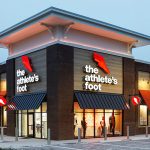The Sports Authority, Inc. swung to a net profit in the fiscal third quarter ended October 29, but also saw a sharp jump in net income when excluding integration costs of merging the TSA and Gart businesses in the year-ago period. The retailer appears to be getting a handle on the operational aspects of the business that has limited their ability to take full advantage of the upside of the merger.
Third quarter sales rose 2.8% to $560.0 million, but comp store sales inched up just 1.2%, still within range of the companys guidance of a 1% to 2% gain for the period. Excluding integration costs in last years Q3, net income jumped more than twenty-fold to $3.5 million, or 13 cents per diluted share, compared to $163,000, or a penny per diluted share, in the year-ago quarter, and beat analysts estimates of nine cents per diluted share. The gain came from a combination of increased sales, improving margins, and flat SG&A expenses as a percent of sales. (View SEW Chart; BOSS Chart)
An increase in store real estate dedicated to apparel looks to be paying off. Chairman and CEO Doug Morton said the top-line got a boost from strong sales of active apparel, fitness, golf, ski apparel, and team sports, and also surprised some with improvements in licensed apparel. The performance apparel category got its energy from Nike, Under Armour, and adidas. Morton also pointed to strength with The North Face and Columbia in the outdoor apparel category.
The CEO said the wheeled sports business showed “somewhat of an improvement” on flat comps, but they continued to see softness in the outdoor category, specifically in hunting, while camping comps were described as “flat.” Footwear suffered a bit from a reduced reliance on promotional events that drove sales last year, but the elimination of “several weeks of BOGO” and three one-time coupon events also helped boost margins in the period.
Mr. Morton said that warmer weather this year had led to a weak start to the ski season. SEW notes that California got a very early start last year, while it remains warmer in the region this year.
The White Sox winning the World Series was seen as “pretty much a wash” versus the Red sox win last year. Management said the BoSox drove more sales volume per store, but the ChiSox drove sales at more stores, thanks to TSAs heavy concentration in the ChicagoLand market with the SportMart stores.
TSA appeared to be most energized by their efforts to reduce inventories, which declined 8.3% on a per square foot basis, or a reduction of roughly $52.3 million versus quarter-end last year. The year-end inventory number is still expected to see a $50 million reduction from year-end last year. The debt number is now expected to be down $45 million at year-end, exceeding previous expectations for a $35 million reduction.
The retailer opened five stores for a total of 397 stores in 45 states at quarter-end and also completed another 27 remodels in the quarter and 53 for the year. The stores remodeled through Q2 are producing mid-single-digit comps sales gains post completion. TSA sees opening or relocating a total of 17 stores this year.
TSA said they were “comfortable” with analysts EPS estimates of $1.07 per diluted share for the fourth quarter and sees comp store sales growth of 1% to 2% generating total sales of $730 million to $740 million for the period. For the year, the company sees diluted EPS of $2.03 on a 1% comparable store sales increase.















